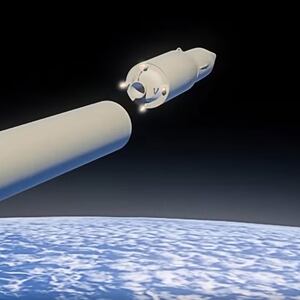The Pentagon's ginormous $718-billion budget request for 2020 is chock-full of fancy new weapons that the military hopes will help it to defeat “peer” forces—the Russians and Chinese, basically—in high-tech battle.
Plus one weapon that critics claim won’t help at all.
Between all the drones, super-fast “hypersonic” weapons, upgraded fighter jets, more drones, do-it-all missiles and yet more drones—all the new gear would cost an eye-watering $143 billion.
Which is more than Saudi Arabia, Russia and India—respectively the third, fourth and fifth biggest spenders on their armed forces—each spent in 2018. China, the No. 2 spender after the United States, dropped at least $168 billion on its military in 2018.
“To preserve the peace, we must be prepared for the high-end fight against peer competitors,” David Norquist, the Pentagon's acting deputy secretary of defense, told reporters. “Future wars will be waged not just in the air, on the land or at sea, but also in space and cyberspace, dramatically increasing the complexity of warfare. This budget reflects that challenge.”
Congress, not the administration, ultimately approves any spending request, so the weapons the Pentagon wants aren't necessarily the weapons it will get. But the high-tech wish-list at least reveals what the military thinks it needs to win future wars.
Robot warships
The budget proposal includes $370 million to pay for two unmanned warships for the Navy. The sailing branch has been struggling to grow from 287 large ships in 2019 to the 350 it says it needs to do battle with Russia and China.
The robotic surface vessels could help to expand the fleet without necessarily breaking the bank. Where a 500-foot-long, old-school destroyer with 300 sailors aboard can cost $2 billion, a 200-foot-long “large-displacement unmanned surface vehicle,” as the robo-ship is known, can carry many of the same weapons for a 10th of the cost.
“Part of the value of having unmanned surface vehicles is you can get capacity at a lower cost,” said Rear Adm. John Neagley, who oversees the Navy’s coming robotic fleet.
Another advantage is that, with no crews at risk, the Navy can deploy robo-vessels on the most dangerous mission. “We will intend to take them into harm’s way,” then-deputy secretary of defense Bob Work said when the Navy in 2016 commissioned its first unmanned test ship.
Robot subs
The same impulses that compelled the Navy to ask for drone surface ships also drove it to request drone submarines.
The undersea fleet is shrinking fast as the nuclear reactor cores wear out on Cold War-vintage boats. U.S. shipyards have the capacity annually to build no more than two new manned subs, too few to halt the fleet's decline.
The Navy in 2016 announced it needed 66 subs. Today, the fleet has 51 attack submarines. The sailing branch expects that by 2028 that number will shrink to 42.
“Where we sit today is, we can’t build ships and deliver them in time to fill in that dip,” Vice Adm. Bill Merz, a deputy chief of naval operations, told U.S. senators.
Unmanned undersea vehicles could help to fill the gap. Like the robotic surface ships, the robotic subs are cheaper than manned vessels but carry many of the same weapons.
The Navy's 2020 budget proposal asks for $180 million for two of Boeing's Orca robo-subs. The 51-foot-long Orca can autonomously sail as far as 6,500 nautical miles. The sailing branch wants to buy a total of nine Orcas by 2024, thus mitigating the shortfall in manned subs.
Speedy rockets
For 2020 the Pentagon is asking for $2.6 billion to develop hypersonic weapons. Super-fast munitions “complicate adversaries' detection and defense,” the budget request explains.
Russia and China also are working on hypersonic weapons. The Kremlin in January claimed it had deployed an operational hypersonic missile.
If a weapon travels five times the speed of sound or faster and is maneuverable, it qualifies as “hypersonic.” The Air Force, Navy and Army all are developing these speedy weapons, but the the Air Force's might be the farthest along.
The Air Force is working on two long-range, Mach-five-plus munitions—the Hypersonic Conventional Strike Weapon and the Air-Launched Rapid Response Weapon.
The flying branch is tight-lipped about these new munitions, but it's safe to assume the former launches from the ground and the latter launches from under the wing of an airborne carrier plane.
Universal missiles
Perhaps the most useful munition in the Defense Department's 2020 budget proposal is a new version of an old missile. Raytheon's SM-6 features components the company borrowed from other missile types. It combines the seeker and blast warhead of an Advanced Medium-Range Air-to-Air Missile and the airframe of the Navy's older SM-2 ship-launched missile.
Of the 10 major missiles that arm the Navy's surface ships and submarines, only the SM-6 can strike ships at sea, planes in the air and rockets at the edge of the atmosphere. Thanks to its versatile seeker and warhead, the SM-6 is arguably America's most versatile missile.
And it's only getting better. With a few modifications, the SM-6 could target enemy ground forces. Swap out the warhead for a torpedo and the missile also could sink submerged submarines.
“A single missile in a single launch tube could thereby provide the warfighter with a range of effects,” missile-expert Thomas Karako wrote for the Washington, D.C.-based Center for Strategic and International Studies. Depending on what it's aiming at, the SM-6 could travel as far as 200 miles.
The Navy is asking for $700 million in 2020 to buy 125 SM-6s.
New-old warplanes
The Pentagon's budget request asks for tens of billions of dollars for hundreds of the latest aircraft, including scores of stealthy F-35s. But perhaps the most controversial plane in the budget is an upgraded version of a 50-year-old fighter jet.
The Air Force is requesting $1 billion to purchase eight F-15EXs from Boeing. This is a heavily upgraded version of a twin-engine, supersonic fighter that the Air Force last bought in 2001.
Today the flying branch operates around 250 older F-15Cs and F-15Ds and mostly deploys them for defensive air patrols over the United States. These F-15s are around 35 years old, on average, and getting increasingly expensive to maintain.
The idea is to directly replace the old F-15Cs and Ds with newer F-15EXs that boast better electronics and a heavier weapons payload. The Air Force reportedly plans to eventually acquire around 180 F-15EXs.
But the F-15EX is big, blocky and decidedly non-stealthy. For that reason, several retired Air Force generals have protested the proposed purchase.
According to them, buying non-stealthy F-15s, even upgraded ones, is inconsistent with preparations to fight Russia and China. “Trying to adopt aircraft that belong in museums to warfare in the 21st century is a mistake,” David Deptula, a former F-15 pilot who is now the dean of the Mitchell Institute for Aerospace Studies in Virginia, wrote in a February op-ed for Forbes.
It's worth noting that the Air Force didn't want the F-15EXs, instead preferring to spend its money on more F-35s. An advisory board reporting to acting Defense Secretary Patrick Shanahan, a former Boeing executive, recommended the F-15 owing in part to the ease of integrating the new-old fighters into existing F-15 squadrons.
Shanahan's office denied reports that the acting defense secretary leaned on officials to add the Boeing-made F-15EXs to the budget.
Space force!
The 2020 budget represents President Donald Trump’s first real chance to begin assembling his beloved “space force.” After strong pushback from military leaders and some lawmakers who argued that the Pentagon doesn’t need an expensive new bureaucracy, Trump in February signed an executive order creating a new space command within the Air Force. The 2020 budget asks for $300 million to transfer around 600 military personnel into the new command.
The space force mostly will make do with the people, rockets and satellites that the Air Force, Navy and Army already possess. But the new command could get one snazzy new satellite, if Congress approves the cash.
The Air Force wants $1.6 billion to quickly develop the new Overhead Persistent Infrared satellite, which would have two main missions. One, it would scan the Earth for enemy rocket launches in order to give U.S. forces a heads up and a chance to shoot back.
But there’s a second, arguably more thrilling mission. In recent years, Russia and China both have deployed a wide array of small, maneuverable “counter-space” satellites that could tamper with or even destroy other craft in orbit. The Air Force’s new infrared sat would also scan space, looking for any Russian or Chinese killer sats that might be trying to sneak up on America’s own spacecraft, hopefully giving them time to maneuver out of the way.







